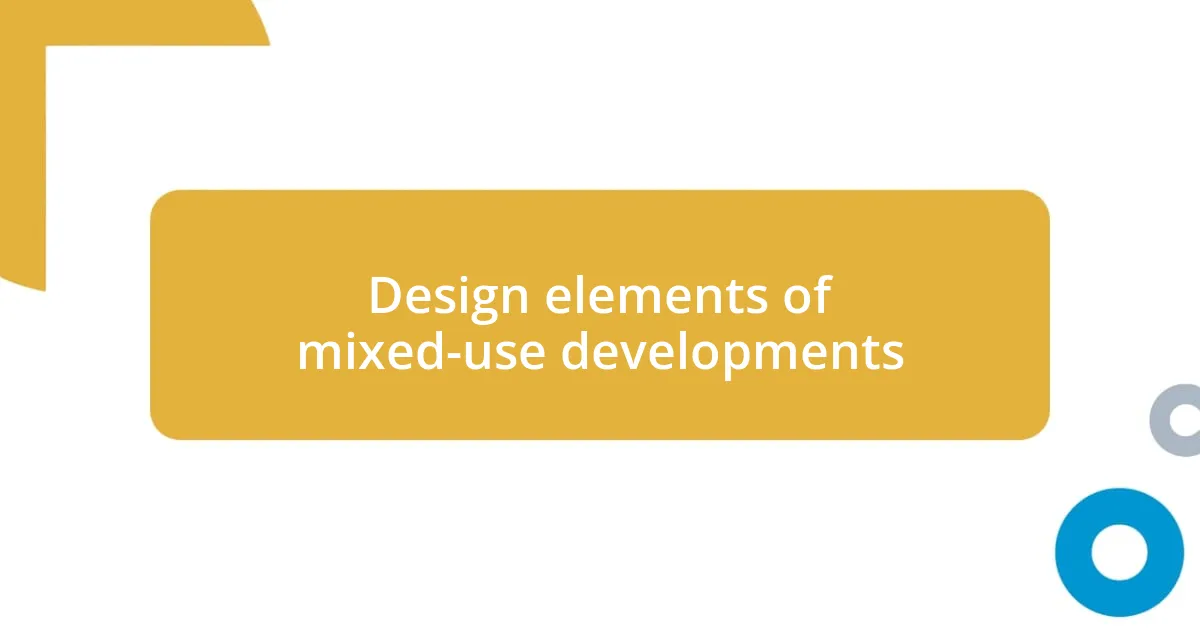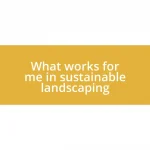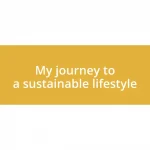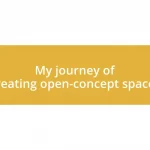Key takeaways:
- Mixed-use developments integrate residential, commercial, and recreational spaces, enhancing convenience and quality of life for residents.
- These developments foster community engagement through social interactions, local markets, and reduced reliance on cars, benefiting local economies.
- Challenges include balancing diverse stakeholder needs, navigating zoning regulations, and ensuring design cohesion among varied uses.
- Future trends focus on sustainability, walkability, and inclusivity in housing options, aiming to create accessible and vibrant urban spaces.

Understanding mixed-use developments
Mixed-use developments blend residential, commercial, and sometimes even industrial spaces within a single project. I remember walking through a vibrant mixed-use neighborhood where people could live, shop, and dine all in one go. It felt like a small town within a city, fostering a sense of community that I really appreciated.
What I find fascinating is how these developments can create convenience for residents. Have you ever imagined living steps away from your favorite coffee shop or a local grocery store? In my experience, having those amenities close by not only saves time but also enhances the quality of life, making daily routines feel a bit more enjoyable.
Moreover, mixed-use developments often contribute to urban revitalization, breathing new life into underused areas. I once visited a repurposed industrial site transformed into a lively hub filled with art studios, restaurants, and parks. It was invigorating to see how thoughtfully integrated spaces can redefine a neighborhood and create places where people want to gather and thrive.

Benefits of mixed-use spaces
The allure of mixed-use spaces lies in their ability to promote community engagement. I recall attending a farmers’ market in a mixed-use development, surrounded by families and friends connecting over fresh produce. It was heartwarming to witness how these spaces encourage social interactions, fostering a sense of belonging that is often hard to find in traditional neighborhoods.
Convenience is another significant advantage of mixed-use developments. One evening, after a long day, I realized I could grab dinner at a cozy restaurant just a short walk from my apartment. Having shops, eateries, and recreational areas within reach significantly reduces reliance on cars, promoting a more sustainable lifestyle. This seamless integration of living and working spaces can truly enhance daily life.
Lastly, mixed-use developments can significantly boost local economies. By attracting diverse businesses and residents, these areas generate foot traffic that benefits everyone. There was a time I visited a mixed-use district where small local businesses flourished amidst the larger retail spaces, creating vibrant economic opportunities. It was a reminder of how revitalizing these environments can invigorate not just the neighborhood, but the entire city.
| Benefit | Description |
|---|---|
| Community Engagement | Fosters social connections through shared spaces. |
| Convenience | Offers easy access to essential services and amenities. |
| Economic Boost | Stimulates local economies by attracting diverse businesses. |

Challenges in mixed-use projects
Mixed-use projects can present a unique set of challenges that often require careful navigation. From my experience, one common hurdle is balancing the needs of diverse stakeholders. I recall a project where residents wanted more green space, while local businesses pushed for expanded parking. It was enlightening to see how tensions simmered when these groups had different priorities, ultimately affecting the development timeline.
Several challenges are frequently encountered in these developments:
- Zoning Regulations: Local laws can restrict how spaces are utilized, complicating planning efforts.
- Financing Complexities: Securing funding can be tougher for mixed-use properties due to their multifaceted nature.
- Cohesion in Design: Ensuring architectural harmony among varied uses is vital but quite challenging.
- Conflict of Use: Noise and foot traffic can create friction between residential and commercial areas.
These elements can lead to unforeseen delays or increased costs, which I have seen firsthand. In one instance, a project I was involved with faced significant pushback due to noise complaints from nearby residents, forcing the developer to rethink its design entirely. This experience reinforced the importance of ongoing communication and collaboration among all parties involved.

Design elements of mixed-use developments
The design elements of mixed-use developments play a crucial role in creating vibrant and functional spaces. I remember visiting a mixed-use project that blended residential areas with lively storefronts, and the way the buildings were oriented encouraged foot traffic. Instead of just a single entrance, there were multiple access points that seemed to invite passersby in, creating a natural flow and interaction among tenants and visitors.
In my experience, incorporating communal areas, such as parks or plazas, is essential to foster community connections. There was a development I explored that featured a beautiful rooftop garden, serving as a shared space for both residents and local eateries to host events. It was during an open-air movie night there that I really appreciated how these design elements create opportunities for social engagement—nothing beats mingling with strangers over popcorn and laughter under the stars!
I’ve often thought about the importance of mixed-use design in enhancing urban sustainability. One evening, while walking through a development, I noticed dedicated bike lanes and pedestrian walkways that seamlessly linked the residential units to shops and offices. It made me realize how thoughtful design can not only reduce carbon footprints but also make everyday activities more enjoyable and convenient. Isn’t it inspiring to think that how we design our spaces can influence our lifestyles?

Successful examples of mixed-use developments
One standout example of successful mixed-use development is the Glenwood Park project in Atlanta, Georgia. I remember walking through this vibrant area, where I was struck by how seamlessly residential, retail, and recreational spaces merged. The combination of cozy townhomes next to bustling cafes and parks created a sense of community that felt alive and welcoming. Doesn’t it feel great to see neighborhoods thriving with people engaging in everyday life?
Another impressive instance is the Hudson Yards in New York City, which showcases the power of innovative design. When I visited, I was taken aback by the striking architecture and the diverse experiences available—from shopping to dining and even art exhibits. It seemed like every corner turned into an opportunity for connection and engagement. The atmosphere there begs the question: how can mixed-use developments revolutionize urban landscapes and foster more interaction among people?
Lastly, the iconic Gas Works Park in Seattle is an inspiring model of integrating green spaces into mixed-use developments. I vividly recall a sunny afternoon gathering with friends at the park, overlooking the stunning views of Lake Union while enjoying food from nearby vendors. The blend of residential, commercial, and recreational areas not only enhances the quality of life but allows for spontaneous moments that create lasting memories. Isn’t it beautiful how these developments can elevate our everyday experiences?

Future trends in mixed-use planning
Mixed-use planning is evolving rapidly, driven by sustainability and community engagement. I recently attended a workshop about the rise of smart technologies in urban planning, where it became clear that integrating tech solutions—like smart meters and energy-efficient systems—will be crucial. This makes me wonder: how can these advancements not only make our cities greener but also connect us in ways we haven’t yet imagined?
Another trend I’m noticing is the increasing emphasis on walkability and public spaces. One weekend, I strolled through a newly designed mixed-use area with ample sidewalks and interactive spaces that encouraged people to linger. Seeing families picnicking and friends chatting over coffee really highlighted how design can make streets feel friendly and accessible. It’s fascinating to think that these spaces can enhance our daily experiences, allowing moments of connection to spring up naturally.
There’s also a shift towards incorporating diverse housing options within mixed-use developments. During a recent visit to a community forum, I observed lively discussions about affordability and accessibility in housing. People expressed desires for units that cater not just to affluent residents, but to everyone in the community. It left me reflecting on the power of mixed-use projects: what if they could truly embody inclusivity and become places where all voices are heard?














